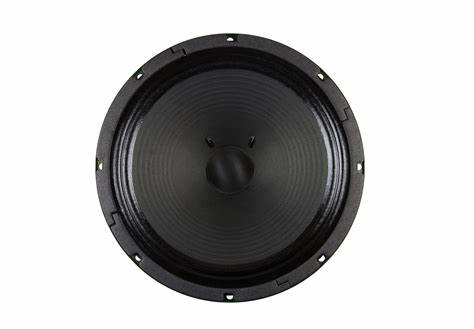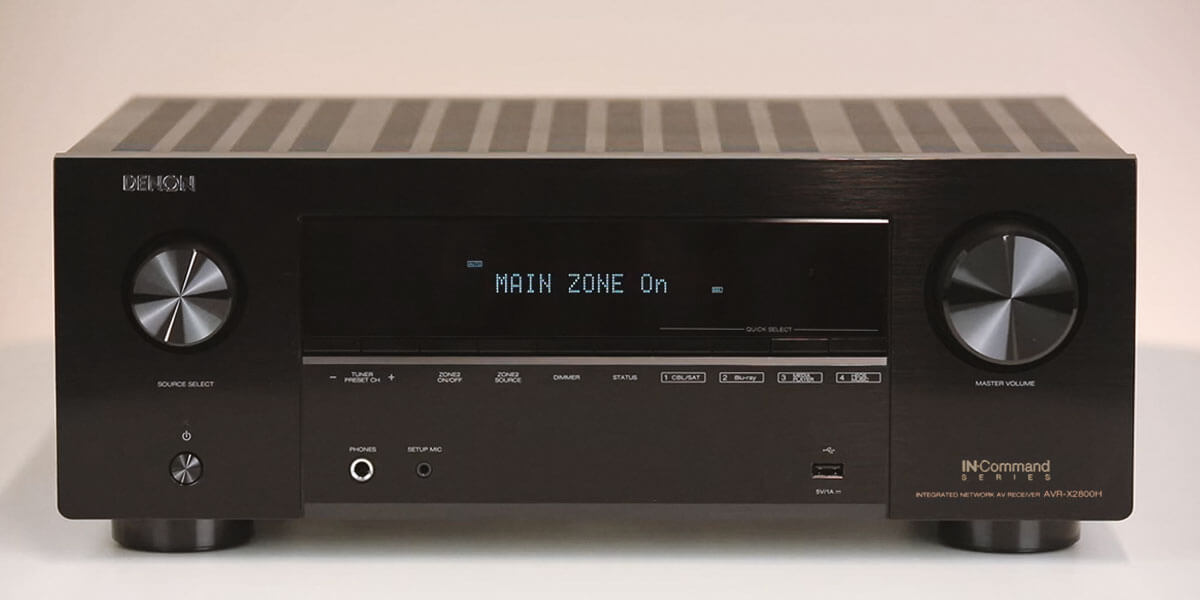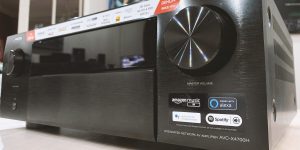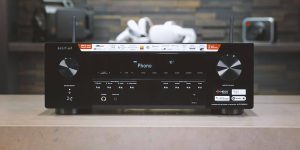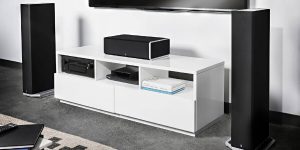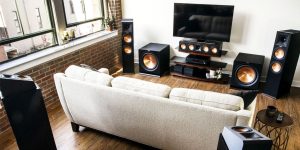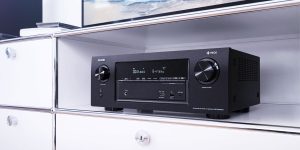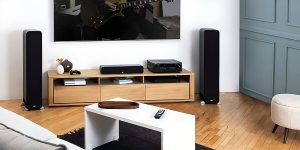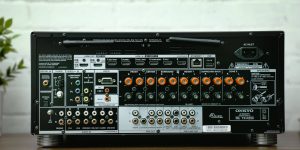What home theater receiver should I choose? It is the most common question I hear from beginners. Well, let’s find out.
First of all, you need to understand what budget you are willing to allocate for such a purchase. You should also consider how and where you plan to use it. In this review, I have chosen the best 7 channel receivers for you because they usually meet most people’s needs. But before I proceed to an overview of the models themselves, we will look at a few important technical points.
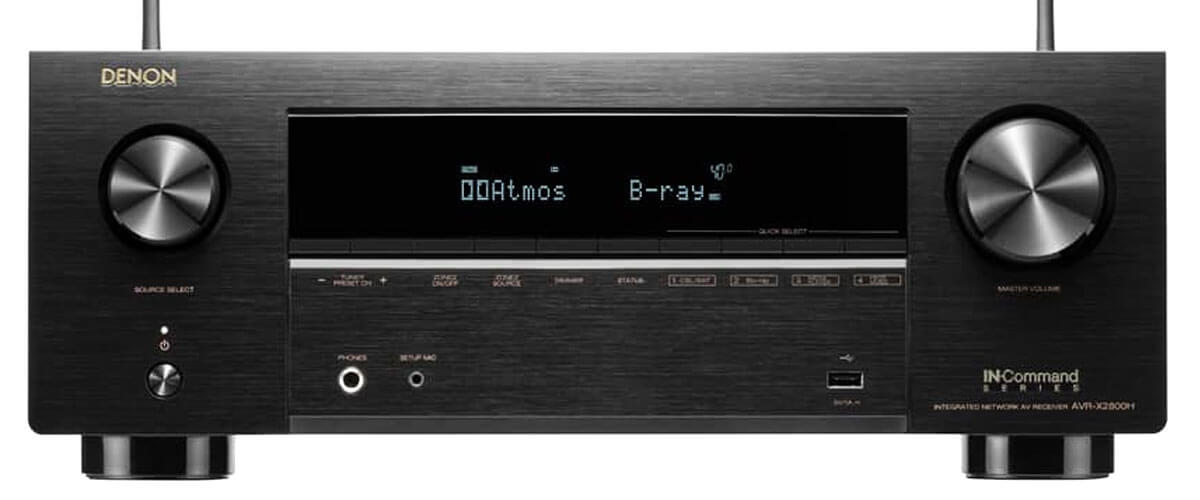
7 channel AV receiver comparison table
| Name | Channels | Power output | HDMI in/out | Bluetooth/Wi-Fi | Review |
|---|---|---|---|---|---|
| Denon AVR-X2800H best overall | 7.2 | 95W/8 Ohm, 125W/6 Ohm | 6/2 | yes/yes | Review |
| Sony STR-DH790 budget | 7.2 | 95W/6 Ohm | 4/1 | yes/no | Review |
| Marantz CINEMA 60 | 7.2 | 100W/8 Ohm, 140W/6 Ohm | 6/2 | yes/yes | Review |
| Yamaha RX-A2A | 7.2 | 80W/8 Ohm | 7/1 | yes/yes | Review |
| Pioneer Elite VSX-LX105 | 7.2 | 100W/8 Ohm | 6/2 | yes/yes | Review |
7 channel home theater system explained
The 7.2 home theater system is the most popular surround sound speaker layout, which the manufacturers of new receivers are increasingly using. It includes all the components of a 5.1-channel system, as well as adds two rear speakers and one subwoofer.
Advantages of 7.2 channel system
The first plus is the more significant number of channels. This home theater system divides the surround and rear channel information into four channels. Thus, you can get more depth of surround sound and a directional sound field in the case of large rooms.
Also, many of these receivers offer the Power Zone 2 option. That way, you get a standard 5.2-channel home theater setup in the main room, and you can use the two additional channels to power the speakers elsewhere.
Another advantage is the ability to expand surround sound. Even if you use regular DVDs (e.g., Dolby Digital, DTS 5.1 soundtracks, and so on), you can easily extend the surround sound to 7.1. For this, you need to use the Dolby Pro Logic IIx or 7.1 DSP extension.
Disadvantages of 7.2 channel system
The disadvantages include the fact that you need to have more space, as often more channels mean more speakers and wires. In other words, a 7.2-channel system would be very cramped in a small room.
Best 7 channel AV receiver reviews
Denon AVR-X2800H – best overall

I’m going to start with my favorite – Denon AVR-X2800H. The company released it in 2022, and since then, it has established itself well, as evidenced by numerous customer reviews. So now, let’s take a closer look at what makes this model so good.
This 7.2-channel receiver has an amplifier with 95 watts per channel (8 Ohms, 20Hz – 20kHz, 0.08% THD, 2ch Drive). The design is not much different from other Denon models. The AVR-X2800H has a black matte panel with source selection and voice control knobs on the left and right sides, respectively. In the center of the case, there is a well-readable LCD. The power button, USB connector, Phono input, and a mini-jack for auto-calibration are in the corners.
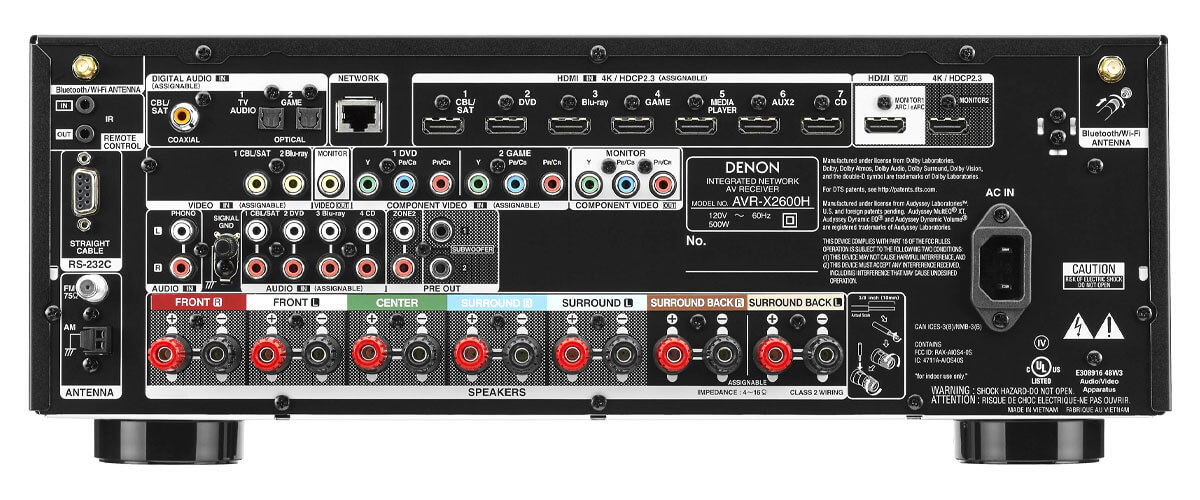
As for the picture, the receiver supports 8K resolution at 60Hz, 4K at 120Hz, and the latest HDR formats. As a result, the images on the screen look tasty and bright. By the way, there are VRR, ALLM, and QFT (functions for optimized gameplay). In general, the device is built in such a way as to bring maximum pleasure to both movie fans and game lovers.
Now a little more detail about the connectors and connection methods. The AVR-X2800H has 6 HDMI inputs and 2 HDMI outputs, with HDCP 2.3 and eARC support. 3 of the 6 HDMI inputs and all outputs are version 2.1 and support 8K pass-through. As for connection methods, these include 2 subwoofer outputs, Bluetooth, Wi-Fi, an Ethernet port, and Phono In. Interestingly, despite the model having analog inputs, it has no analog-to-digital converter, which in turn means that such ports are useless. If you need to use them, you must have a third-party device to do so.

What about the sound? I want to say that the calibration is a little bit upsetting to me. After using the Audyssey MultEQ XT, I had to adjust the volume of individual channels myself because the dialogue in some scenes was hard to hear. But ultimately, it was worth it. After adjusting correctly, the sound was top-notch. The clear dialogues and the incredible sounds of the special effects (I watched Doctor Strange 2) are commendable.
As you can see, this is a great example of a modern receiver that seamlessly combines basic features with modern technology. In my opinion, the Denon AVR-X2800H is the best 7.2 receiver with everything you need to become the main link in your multimedia system.
Key specs
- Channels: 7.2.
- Power output: 95W/8 Ohm, 125W/6 Ohm.
- HDMI inputs/outputs: 6/2.
- Video functions: 8K/60Hz, 4K/60Hz, 4K/120Hz, HDMI Upscaling up to 8K.
- Bluetooth/Wi-Fi: yes/yes.
- Streaming services: AirPlay 2, Spotify, TuneIn, Deezer, Tidal, Netflix, Amazon Prime.
- Supports: HDR, HLG, HDMI ARC, HDMI eARC, HDMI CEC, HDCP2.3, HDR10+, Dolby Vision, Dynamic HDR.
- Surround sound: DTS:X, DTS Virtual:X, DTS Neural:X, DTS HD Master, Dolby Atmos, Dolby TrueHD, Dolby Atmos Height Virtualization, Dolby Surround.
Pros
- 8K resolution.
- Full 3D audio support.
- Supports the latest HDR formats.
- Receiver is game-oriented.
- 2 multi-room zones.
- Phono In.
Cons
- No analog-to-digital converter.
- It takes time to adjust the sound correctly.
Sony STR-DH790 – budget

Next, I want to draw your attention to the STR-DH790. It is the oldest model on my list, as Sony released this receiver in 2018. The 5.2 channel STR-DH590 is its younger brother.
The receiver is equipped with a 7.2-channel amplifier with 145 watts of power, as it is written on the box itself (6 Ohms, 1 kHz, 1ch THD 0.9%). But such a large figure is nothing more than a marketing ploy. In fact, the unit has about 67 watts per channel (or a little more) at 8 Ohms impedance. The disadvantage is that the model is not designed to work with 4-Ohms loudspeakers.

The STR-DH790 plays back video content in 4K resolution, supporting HDR and 3D formats via HDMI. Although the picture is far from perfect, it is at a sufficient level. The only thing that made me tense was that the system always starts in the settings menu. So you’ll see the settings menu every time you turn on the receiver instead of going straight to viewing.
It has 4 HDMI inputs (2.1) and 1 HDMI output (2.1/eARC) with HDCP 2.2 support. Available connectivity options include 2 subwoofer outputs and Bluetooth with AAC. However, a significant disadvantage of this model is the lack of connectivity via Wi-Fi.
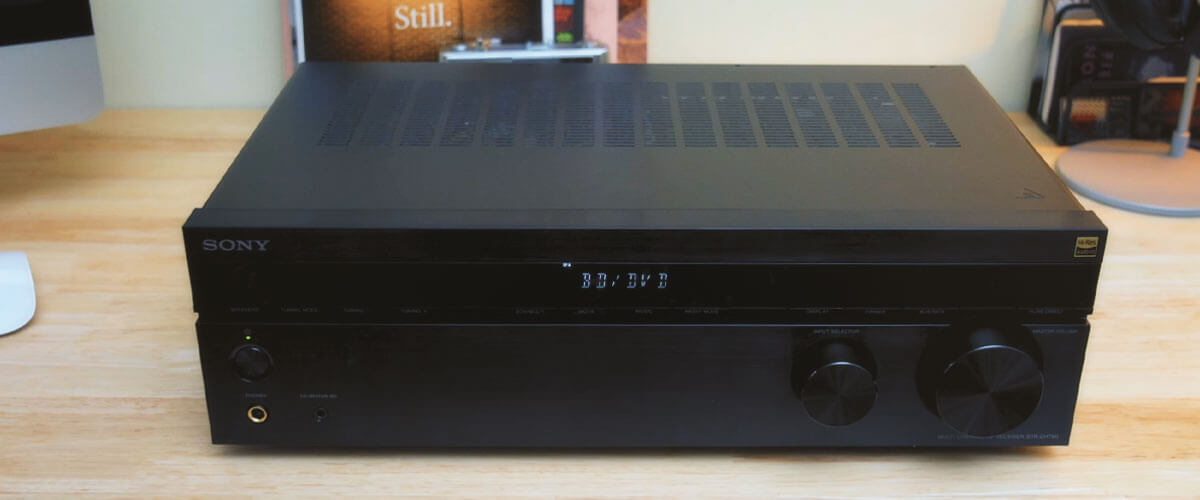
Sony STR-DH790 supports Dolby Atmos and DTS:X. This is its main advantage because not every model for such a modest price can offer its users support for surround sound. After calibrating the receiver via Advanced D.C.A.C., the soundtracks started playing clearer, even though the music was showing good results before that.
In short, the STR-DH790 is the best budget 7.2 receiver with surround sound at a fairly low price. If you are satisfied with the small number of ports and AVR performance, this is an excellent solution for you.
Key specs
- Channels: 7.2.
- Power output: 90W/6 Ohm.
- HDMI inputs/outputs: 4/1.
- Video functions: 4K/60Hz pass-through.
- Bluetooth/Wi-Fi: yes/no.
- Streaming services: no.
- Suppots: HDMI ARC, HDMI CEC, HDCP2.3, HDR10.
- Surround sound: DTS: X, DTS-ES, DTS HD Master, Dolby TrueHD, Dolby Digital Plus, Dolby Atmos.
Pros
- Dolby Atmos and DTS:X.
- 4K pass-through.
- Bluetooth with AAC.
- HDMI ports version 2.1.
- Great value for money.
Cons
- No Wi-Fi and Ethernet network.
- Not compatible with 4-ohms speakers.
- Uncomfortable system firmware.
Marantz CINEMA 60
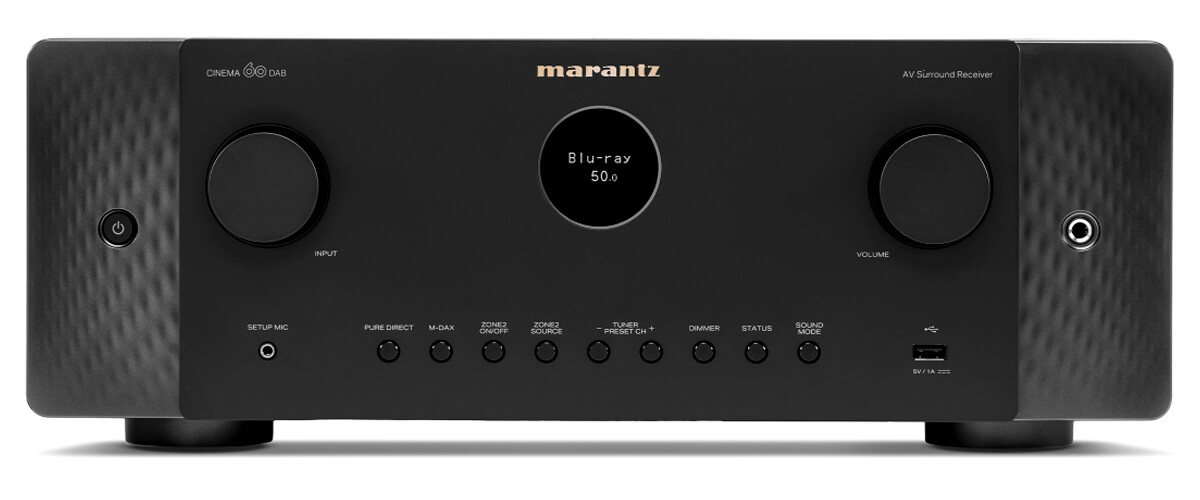
The next receiver in line is the most expensive of all the devices in this review, the CINEMA 60. After Marantz launched the CINEMA series in 2022, it became one of the most popular AVR manufacturers in the luxury segment.
The receiver is equipped with a 7.2-channel amplifier with about 100 watts of power per channel (8 Ohms, 20Hz – 20kHz, THD 0.08%, 2ch Drive). It also has OvrC and Domotz Pro, remote monitoring and control technologies that check installed electronic components and maintain your network. Similar products can’t boast anything of this kind.
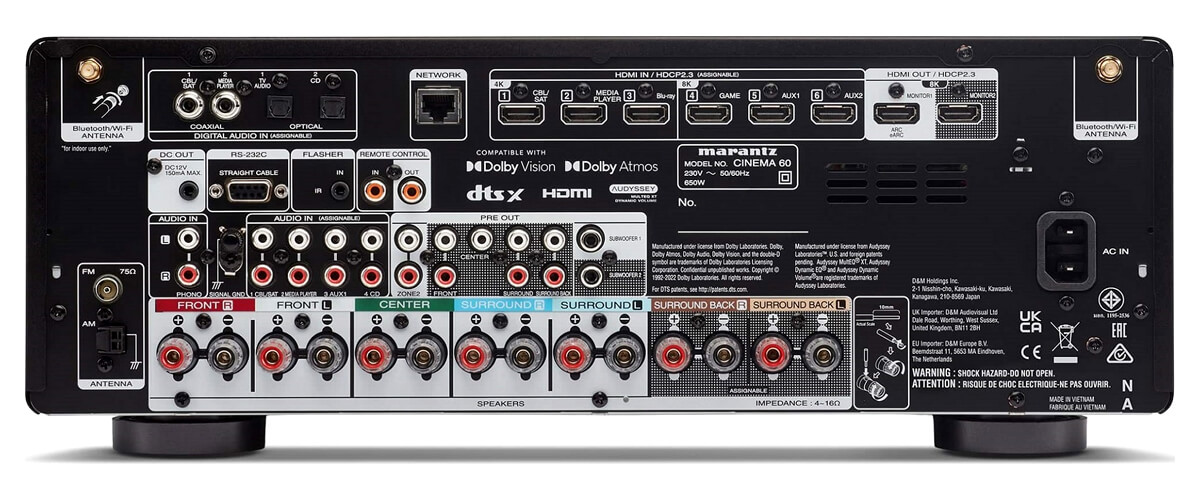
CINEMA 60 works in 8K resolution (60Hz) and supports Dynamic HDR, HDR10+, Dolby Vision, HLG, 3D, and others. Support for the latest video formats also makes it stand out from the competition. The picture looks at a very high level. And, of course, VRR, ALLM, and QFT are also present.
As for its disadvantages, here I would include a small display. Sometimes it’s really hard to see any information from afar. Also, the user interface is very limited. Perhaps some people prefer to avoid going into all the details, but this is definitely not my case.
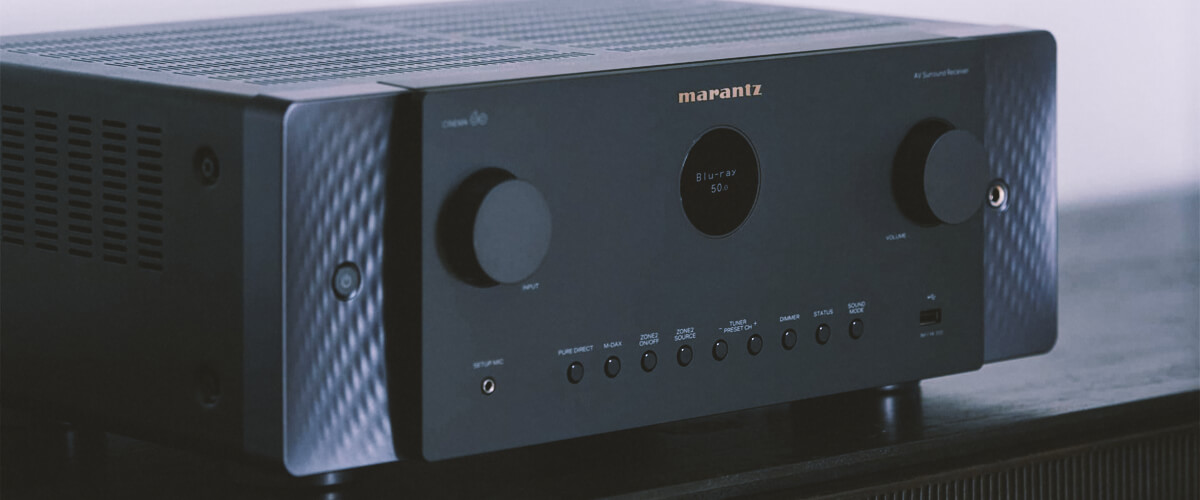
This 7.2 home theater receiver has 6 HDMI inputs (2.1) and 2 HDMI outputs (2.1) with HDCP 2.3 and ARC/eARC support. In addition, you will find Wi-Fi, Bluetooth, Ethernet ports, and Phono (MM) input among the available connection methods. You can also connect to the device through 2 subwoofer outputs, but here there is one important nuance. Since the subwoofer outputs are connected in parallel, you cannot tune each subwoofer independently.
The Marantz CINEMA 60 supports Dolby Atmos and DTS:X formats. After a quick and fairly easy calibration via Audyssey MultEQ XT, the sound became a little warmer and more pleasant to the ear. As for the multi-room function, it supports both 2 multi-room zones and wireless HEOS.
The CINEMA 60 is an improved version of its predecessor, the SR5015. In addition to pretty high performance and ease of use, it can also offer its customers high-quality sound and really advanced video capabilities.
Key specs
- Channels: 7.2.
- Power output: 100W/8 Ohm, 140W/6 Ohm.
- HDMI inputs/outputs: 6/2.
- Video functions: 8K/60Hz, 4K/60Hz, 4K/120Hz, HDMI Upscaling up to 8K.
- Bluetooth/Wi-Fi: yes/yes.
- Streaming services: AirPlay 2, Spotify, TuneIn, Deezer, Tidal, Netflix, Amazon Prime.
- Supports: HDR, HLG, HDMI ARC, HDMI eARC, HDMI CEC, HDCP2.3, HDR10+, Dolby Vision, Dynamic HDR.
- Surround sound: DTS:X, DTS Virtual:X, DTS Neural:X, DTS HD Master, Dolby Atmos, Dolby TrueHD, Dolby Atmos Height Virtualization, Dolby Surround.
Pros
- 8К pass-through.
- Dolby Atmos and DTS:X.
- VRR, ALLM, and QFT support.
- 2 multi-room zones and HEOS technology.
- OvrC and Domotz Pro.
- Phono (MM) input.
Cons
- Tiny and uncomfortable display.
- The user interface is too limited.
- 2 dependent subwoofer outputs.
Yamaha RX-A2A
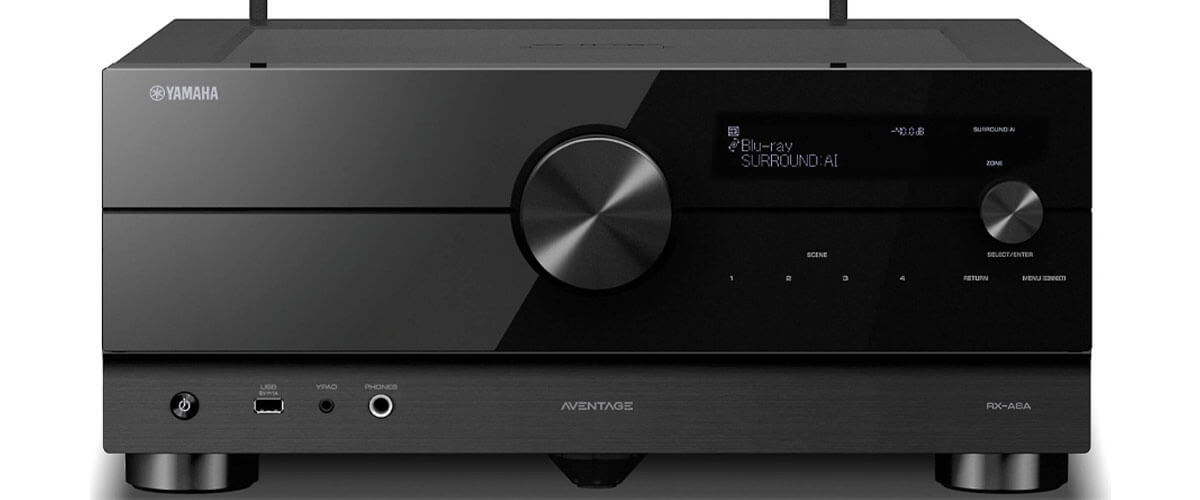
The penultimate device for today is the RX-A2A. This model was released by the well-known Japanese company Yamaha in 2020 and marked the beginning of the new RX-A series.
The unit has a 7.2-channel amplifier with about 100 watts per channel (8 Ohms, 20Hz – 20kHz, 0.06% THD). As for its hardware, the RX-A2A is equipped with a 384kHz/32-bit BB PCM5102A DAC. Other premium models, such as the RX-A4A, have the newer Qualcomm QCS407 64-bit processor. But you should also consider that the price of the RX-A4A is quite different.
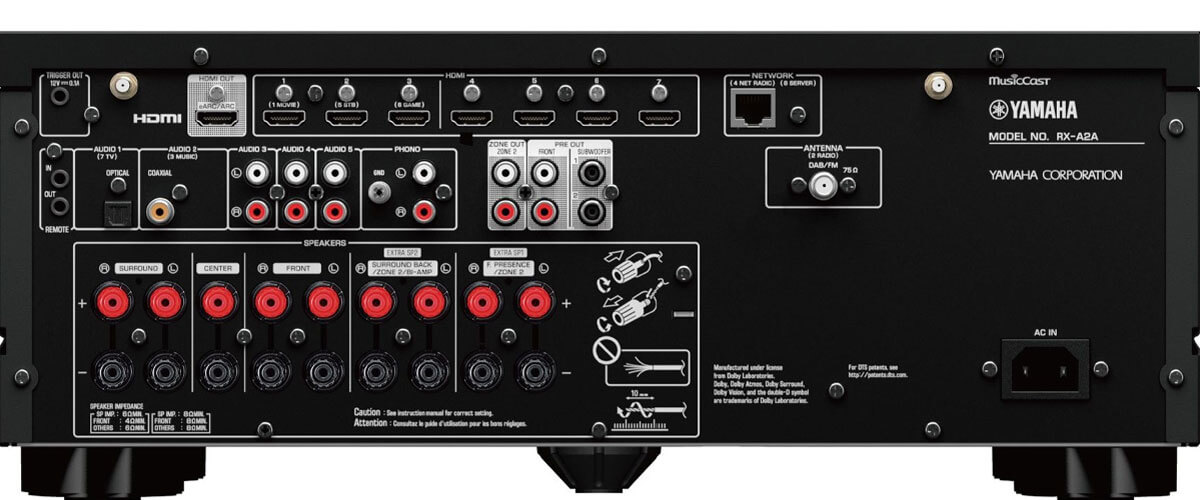
Yamaha boasts a wide range of video features and technology. They include support for 8K resolution (60Hz), HDR10+, and Dolby Vision. The picture looks bright, clear, and dynamic. And the presence of such technologies as ALLM, VRR, QMS, and QFT, is just what you need to add some bright colors to your home entertainment. Even though some users complained about unstable signal transmission in their reviews, I didn’t notice this during the test; therefore, I can not say this is a disadvantage. Also, this receiver (like the other models in the review) supports two multi-room zones.
The receiver has 7 HDMI inputs (2.1) and 1 HDMI output (2.1) with HDCP 2.3 and eARC support. As for connection methods, you have two subwoofer outputs, Bluetooth, USB inputs, Wi-Fi, Network ports, and Phono (MM) In, which is not bad.
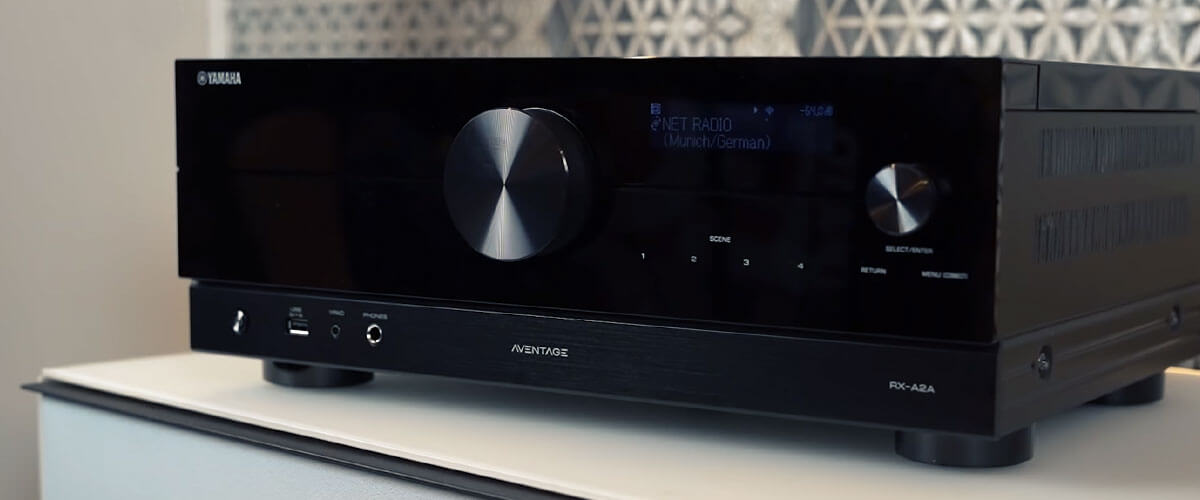
RX-A2A supports the latest surround sound formats and CINEMA DSP 3D mode. While watching “The Avengers,” I could feel many of the intense scenes to the fullest. The explosions, fights, and battle scenes were just on a cosmic level! The main stage sounds pleasant enough with Yamaha’s characteristic warmth, while the background music is only neatly detailed.
The Yamaha RX-A2A is a really good receiver of a well-known brand that can meet most of your needs and will keep you going for many years. Moreover, it certainly guarantees excellent sound and video quality!
Key specs
- Channels: 7.2.
- Power output: 80W/8 Ohm.
- HDMI inputs/outputs: 7/1.
- Video functions: 8K/60Hz, 4K/60Hz, 4K/120Hz, HDMI Upscaling up to 4K.
- Bluetooth/Wi-Fi: yes/yes.
- Streaming services: AirPlay 2, Spotify, TuneIn, Deezer, Tidal, Netflix, Amazon Prime.
- Supports: HDMI ARC, HDMI eARC, HDMI CEC, HDCP2.3, HDR10+, Dolby Vision.
- Surround sound: DTS:X, DTS Virtual:X, Dolby Atmos, DTS HD Master, Dolby TrueHD.
Pros
- 8K pass-through.
- Amplifier with high slew rate.
- CINEMA DSP 3D.
- Easy setup via YPAO.
- 2 multi-room zones.
- DTS:X and Dolby Atmos.
- Phono (MM) In.
Cons
- No HDMI port on the front panel.
- The receiver’s front display is hard to read.
Pioneer Elite VSX-LX105

And I want to finish this review with the Pioneer Elite VSX-LX105. It was made by the Japanese company in 2021. This is the case when the most affordable model of the LX series is still an interesting option and doesn’t lose against the background of more expensive units.
The receiver is equipped with a 7.2-channel amplifier with about 100 watts per channel (8 Ohms, 20Hz-20kHz, THD 0.08%). This device is also Roon, and Sonos certified, which means it is perfectly compatible with all devices and ready to join the Sonos ecosystem without any problems.
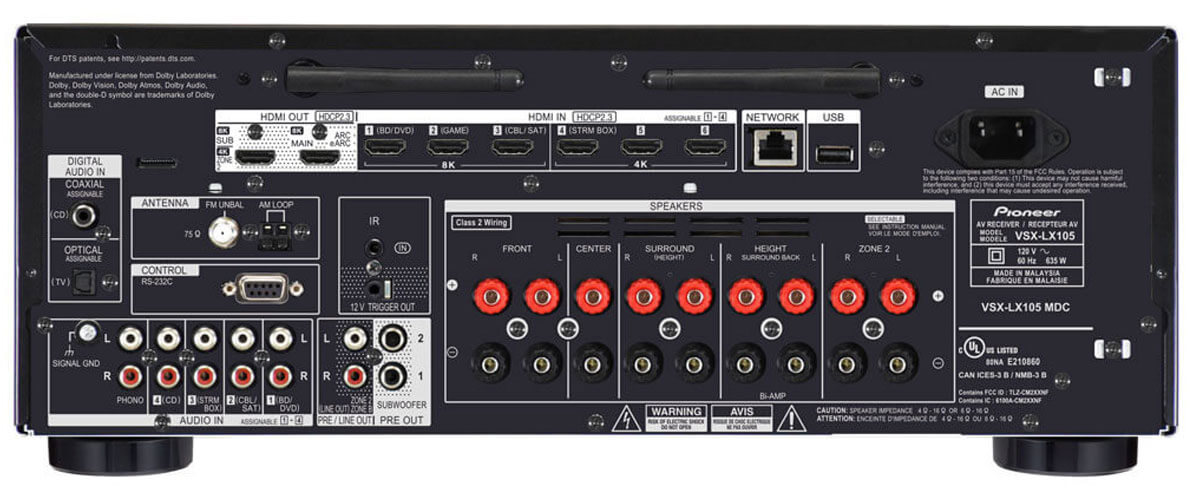
If we talk about the video capabilities of the model, everything is more or less standard for devices of this class. That is, there is an 8K resolution and supports the latest HDR formats. Useful technologies and modes include ALLM, VRR, and QFT. The picture looks quite decent. I can’t say anything outstanding, but nothing bad, either.
This 7-channel AV receiver will also allow you to listen to or watch different content simultaneously in separate rooms of the house, thanks to 2 multi-room zones support. However, it is worth pointing out that an 8K pass-through is only available in the first zone.

As for connectors and connection methods, the Elite VSX-LX105 has 6 HDMI inputs (2.1) and 2 HDMI outputs (2.1) with support for HDCP 2.3 and eARC. Also, you can connect to the device thanks to two subwoofer outputs, Ethernet ports, dual-band Wi-Fi, and Bluetooth 4.2. The presence of Phono input will become a nice bonus for vinyl lovers.
Now let’s talk about the sound itself. During the calibration with MCACC automatic room tuning technology, I had no problems. The sound really started to play more focused and clearer. Even though I like to listen to music quite loudly, the bass sounded without any noise. But I noticed that after listening for a long time, the receiver sometimes heats up. That’s why in case of such a purchase, I recommend you buy a cooling fan right away.
The Pioneer Elite VSX-LX105 is a good solution for most average users. If you are not an advanced audiophile or a fan of the most innovative technology, this “Beauty” is definitely for you.
Key specs
- Channels: 7.2.
- Power output: 100W/8 Ohm, 210W/6 Ohm.
- HDMI inputs/outputs: 6/2.
- Video functions: 8K/60Hz, 4K/60Hz, 4K/120Hz, HDMI Upscaling up to 8K.
- Bluetooth/Wi-Fi: yes/yes.
- Streaming services: AirPlay 2, Spotify, TuneIn, Deezer, Tidal, Netflix, Amazon Prime.
- Supports: HDMI ARC, HDMI eARC, HDMI CEC, HDCP2.3, HDR10+, Dolby Vision.
- Surround sound: DTS:X, DTS Virtual:X, Dolby Atmos, DTS HD Master, Dolby TrueHD.
Pros
- 8K pass-through.
- Full 3D audio support.
- Game-oriented.
- Supports the latest HDR formats.
- Roon and Sonos certified.
- 2 multi-room zones.
- Phono input.
Cons
- The model can overheat.
- No front-wide channel support.
- 8K resolution available only in Zone 1.
7.2 receivers buying guide
Although receivers have different characteristics, some common points will allow you to determine a decent 7.2-channel unit. Most of all, you should pay attention to the following parameters while buying:
- The receiver power
- The number of connectors
- The connection methods and streaming audio services
- The video resolution
- The device’s sound capabilities
Recently, people have begun to pay more attention to such a parameter as the device’s power. However, its importance is often overestimated, and many companies continue to compete with each other by offering more and more watts. But you should understand that the receiver’s power greatly affects its price tag. For small to medium-sized rooms, 70-100 watts per channel is fine. That’s why all the receivers in my review have approximately the same power parameters.
The following essential aspect of choosing the suitable device for you is the number of connectors. Before buying, you should decide how you will mainly use it because some models may not have extra subwoofer output or other ports you need.
Of the important things, you should pay attention to the presence of support for eARC and HDMI ports version 2.1. With these technologies, you can get higher frame rates and achieve full-resolution signal transmission without losing quality.
I believe connection methods such as Wi-Fi and Bluetooth should definitely be present in a modern receiver. As for streaming audio services, it would be nice to see support for Deezer, Tidal, Spotify, Apple Music, and others.
As a rule, 7-channel receivers support 4K or 8K resolution. However, I prefer 4K because this resolution is suitable for most televisions and boasts support for a lot more video content than 8K pass-through.
Most models with a 7.2 surround sound system support DTS:X and Dolby Atmos technologies. To experience better surround sound with an enveloping effect, you should consider 9.2-channel receivers and above. They already have support for Auro-3D technology.
